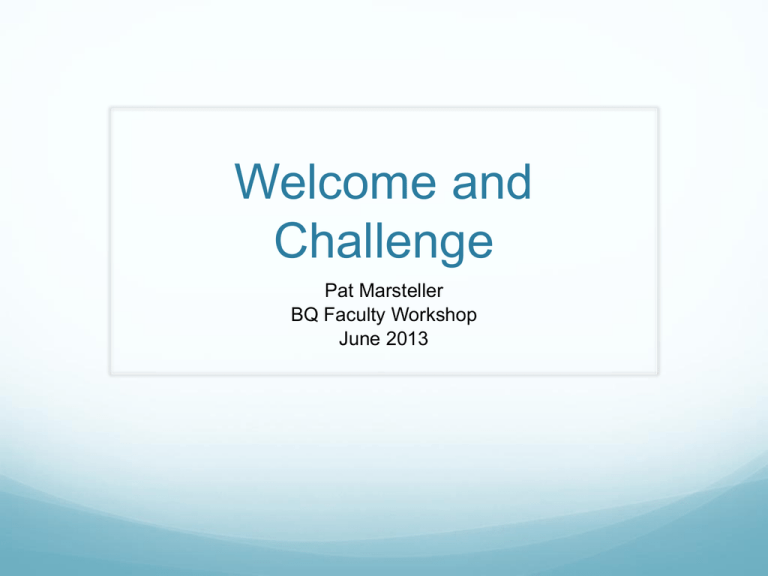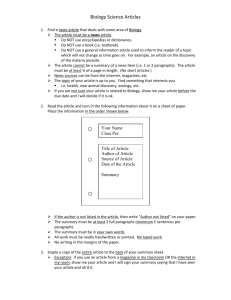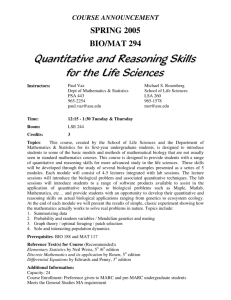Welcome and Challenge - BioQUEST Curriculum Consortium
advertisement

Welcome and Challenge Pat Marsteller BQ Faculty Workshop June 2013 Cases, Data, Simulations, Tools We use Math Everyday! http://www.youtube.com/watch?v=TaAftRgptkQ Reports, Reports, Reports Using Data in Undergraduate Science Classrooms (2002) Shaping the Future: New Expectations for Undergraduate Education in Science, Mathematics, Engineering, and Technology (NSF 96-139) Shaping the Future Volume II: Perspectives on Undergraduate Education in Science, Mathematics, Engineering, and Technology NSF 98-128 NRC Board on Life Sciences (2003) NRC Board on Life Sciences (2009). MAA (2004) MAA (2005) American Association for the Advancement of Science & National Science Foundation (2011) Association of American Medical Colleges & Howard Hughes Medical Institute (2009) College Board (2011) Bio 2010 Recommendations Biology education should be interdisciplinary with a strong emphasis on developing quantitative skills. Laboratory courses should focus on developing critical thinking skills. Students should pursue independent research. Teaching methods should be examined. Resources must be adequate. Faculty should be rewarded. Core competencies V&C Fundamental Understanding of the Process of science Quantitative competency and the ability to interpret data Basic computational skills The ability to see connections between biology and other disciplines Competency in communication and collaboration Understanding of how biology is practiced in a societal context with potential to address critical issues in society and global issues National Research Council 2000 National Research Council 2003 9 What are we waiting for? The collaborative investigation of cases (and problem spaces) provides opportunities for learners to share and question what they already know with their peers. Learners come “to formal education with a range of prior knowledge, skills, beliefs and concepts” which affect: • what learners notice, • how they reason and solve problems, • how they remember (p.10). How People Learn: Brain, Mind, Experience and School. National Research Council, National Academy Press, 2000. Effective Learning and Teaching Quality, not Quantity Connects New Knowledge to Old Constructive, restructures old frameworks based on new knowledge Concrete to Abstract: embed specifics in organized, coherent frameworks Relevant and Real Active How People Learn: Brain, Mind, Experience and School. National Research Council, 2000 AP Redesign Biology, Chemistry, Environmental Science, Physics (2012-16) Evidence of Learning • Big Ideas / Unifying Themes • Enduring Understandings • Competencies • Evidence Models (Formative Assessments) • The student can use representations and models to communicate scientific phenomena and solve scientific problems. • The student can use mathematics appropriately • The student can engage in scientific questioning • The student can perform data analysis and evaluation of evidence • The student can work with scientific explanations and theories • The student is able to transfer knowledge across various scales, concepts, and representations in and across domains Next Generation Science Standards Investigate, build models & theories Includes engineering practices Crosscutting patterns, scale, cause & effect etc Core ideas; key concepts, broad import, relate to student interests, learnable across grade levels http://nextgenscience.org/ I repeat What are we waiting for? Cases, Simulations, Games & Problem Spaces Can Integrate Core Concepts and Competencies throughout the Curriculum Introduce science process skills early and reinforce in all courses Learning goals focus on core concepts & assessments align with learning goals Real world examples and relevance Develop lifelong science learning competencies Fewer concepts in greater depth Stimulate curiosity about the natural world Help scientists demonstrate passion for the discipline and delight in sharing passion with students What do you want your learners to do? Learn specific disciplinary content? Use interdisciplinary skills to answer their questions? Develop scientific data literacy? Engage in collaborative problem solving? Relate the disciplinary content to their own lives? Learn how to use tools such as BLAST? Navigate the online environment? Make evidence-based decisions? Develop an appreciation for scientific thinking? Discover their strengths and weaknesses as learners? Shouldn’t all Students Understand the Evidence Behind the Headlines? Wider Warnings after 3rd hanta virus death Corporations Slow to Act on Climate Change Earlier Mass Extinction for Most of Marine Life New York Is Lagging as Seas and Risks Rise, Critics Warn Ovarian Cancer Screenings Are Not Effective, Panel Says Literacy and the Population Problem And Know about Big Questions that remain? http://www.sciencemag.org/site/feature/misc/webfeat/125th/ Why we care ! we have recognized the importance quantitative biology in the undergraduate curriculum we want to identify and share best practices and resources we want to work together to create new materials establish a community of educators who will continue advancing this effort for many years to come properly done, quantitative methods must be part of the first biology courses an undergrad takes (and biological concepts in early mathematical courses,too) To do list efforts must be scalable and sustainable (from fiscal and human resource perspectives) activities should count toward graduation must included research or research-like experiences We must make efforts to push the adoption curve forward make our work visible to those outside this community persuade others that our innovations work prepares students (assessment!) give others the tools and support that will guarantee their success Additional Challenges Increasing STEM undergraduate degree production Increasing participation of traditionally underrepresented groups Involve pre-K thru 12 and community college teachers in “the revolution” Where are we now? General biology texts: have less than 3 equations Rarely have quantitative data Graph complexity primarily linear No quantitative problems Where do we need to go? Biology education that uses calculus, discrete mathematics, & statistics Quantitative problem solving throughout Modeling top down, bottom up, nonlinear feedback Deal with complexity of terabytes of data per day John Jungck 2007 and every time I’ve seen him since 2002 Central role of problem-solving environments: Powerful tools that develop professional skills Interactive Open-ended Challenging Research-related Depth of analysis Empowering Lend themselves to collaborative learning Goals of a Bioscience Curriculum Students should “be conversant not only with the language of biology but also with the languages of mathematics, computation, and the physical sciences” Bialek & Botstein 2004, Science 303:788 Institutionalizing innovations in science education requires Support from faculty Support from administration Recognition through competitive grant funding and national awards Dissemination through articles, books, workshops, and national meetings – Joint Meeting of HHMI Program Directors and HHMI Professors, 2006 The important thing in science is not so much to obtain new facts as to discover new ways of thinking about them. Sir William Bragg (1862 - 1942) Go forth and create new problem spaces! Join us for the HHMI Workshop, too!




